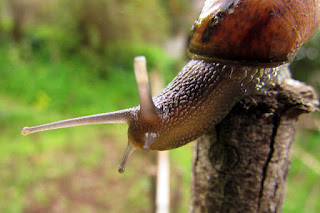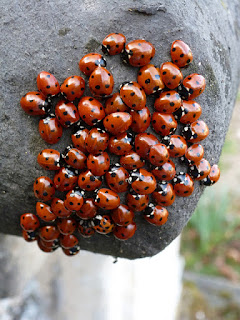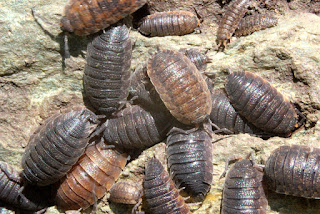By Alida Robey
This week’s post continues to separate the facts from the fallacies concerning the creatures that cross our paths while we garden. In my last post I looked at invertebrates and this week, I look at creatures with feathers and fur.
Is that little robin back again this year?
 |
| Robins live just over a year. Photo credit: Linda Stanley [via Flickr CC by 2.0] |
Unfortunately, this is highly unlikely. Robins are relatively short-lived birds, with an average lifespan of 1.1 years. The oldest known robin lived to 12 years. Compare this with blackbirds (2.4 year average; 20 year max) or starlings (2.5 average; 22 year max). This sadly means that the robin you see in your garden year after year is unlikely to be the same one.
How long do foxes live?
Whilst in captivity, foxes can live as long as 14 years, but they usually live 5 years in the wild. In rural areas where fox control is practised, up to 80% of the fox population may be less than 1 year old.
Foxes can dig their own dens, but sometimes they prefer to simply renovate vacated rabbit holes, or even co-habitate with badgers, amicably occupying the other end of their sett.
Foxes have been known to travel 5-10 miles from their den on their nocturnal hunt for food.
If you are troubled by foxes – and increasingly in urban areas such as Bristol this can be the case – I am reliably informed that rural chicken keepers get the males in their family to take a pee around the hen house. This being one of the best-known deterrents to these wily poachers!
Are moles really blind?
 |
| Moles can create havoc in the garden. Photo credit: Stephan Caspar [via Flickr CC BY-NC 2.0 |
Moles can be the bane of your life if you get them tunnelling in your lawn or garden. These amazing little creatures can shift twice their body weight in soil in a minute, which amounts to 540 times their body weight in a day. This can have a rather disruptive effect on your lawn if you are unfortunate enough to have them as neighbours – and given there are 35-40 million of them in the UK, the chances of that are fairly high! Moles are solitary except when mating and they only surface at night to forage for food and nesting material. They live mainly on worms, grubs and larvae.
Contrary to the popular myth, moles are not blind. They have very small eyes as they spend so much time tunnelling. Their eyes are light-sensitive, but don’t detect colour; they rely heavily on sound and smell. They are the only mammal that lives totally underground. Their blood composition allows them to cope with significantly less oxygen than other mammals require.
How far do hedgehogs travel?
Hedgehogs travel up to 3 km a night in search of food. They can swim and even climb the lower branches of hedges in search of bugs and caterpillars. Their spindly little legs can help them reach speeds of up to 4.5 mph if they need to, which is more than twice my average pace as a steady walker (with significantly longer legs)!
 |
| Hedgehog numbers are in decline. Photo credit: Milo Bostock [via Flickr CC BY 2.0] |
We do love hedgehogs, yet we don’t seem to love them enough, as their numbers are in drastic decline due to human lifestyle choices. Whilst hedgehogs can live 10 years with a bit of care and attention, their average life in today’s urban environment is only 2-3 years with 20% of baby hoglets dying before they even show their little noses out of the nest. A large number then die during their precarious first hibernation. Roadkill, pesticides and urban development contribute to mortality, so less than 0.4% ever reach 10 years of age.
A hedgehog diet is mainly slugs, snails and beetles, but they also eat worms and spiders, and occasionally carrion and birds eggs. Milk and bread that is left out for these carnivores can actually be fatal to them. And to dispel yet another myth, hedgehogs do have fleas, but these are a variety exclusive to hedgehogs and will not transfer to pets or humans. It is also the case that if you should try to treat any hedgehogs you find with other animal flea treatment you will again almost certainly kill the poor hedgehog.
Hibernation gets the hedgehog through winter when the availability of its normal diet is scarce. To cope, its body temperature drops from 35 degrees Celsius to around 4 degrees Celsius. It breaths only every 6 seconds and drops its heartbeat to one tenth the normal rate. A hedgehog can lose around half its body weight in the process of getting through the long cold winter.
The stark fact is that without drastic measures by householders and others, hedgehogs are heading rapidly towards extinction having fallen in number from some 30 million in the 1950s to 1.1 million by 1995 and further loss since then means there are now fewer than a million left in the UK.
Slug bait and pesticides kill hedgehogs, so if you want to do your bit, then please do consider nematodes and other hedgehog-friendly pest control methods. Nematodes can be bought online and simply watered onto your garden a few times a year. Doing so as an alternative to slugbait should help both your bird population and any of the few remaining hedgehogs in the country – both of which will help reduce slug devastation in your garden. Worms, birds, hedgehogs and many other wild creatures perform vital ecosystem services for us – they are workers in our gardens and countryside. The more we protect them, the more help they give. So when you are fighting the battle to take control of the unruly creatures in your garden remember to keep some room for ‘the wild side!’







